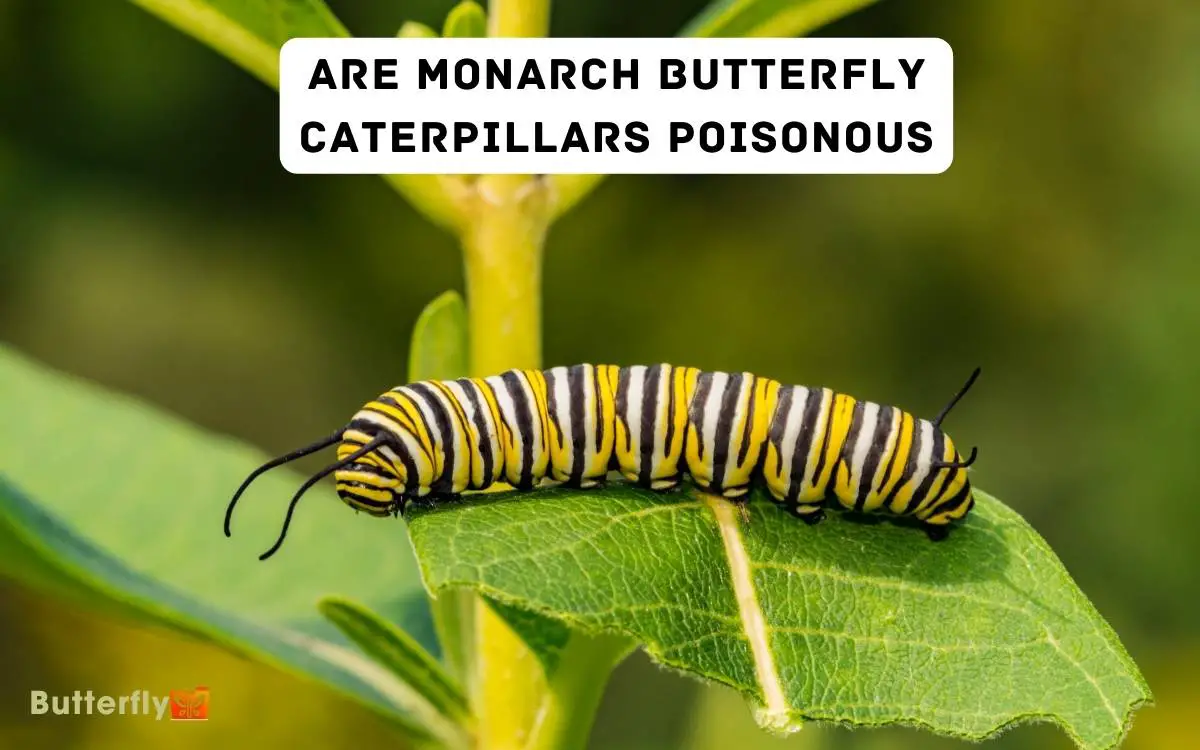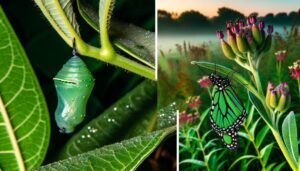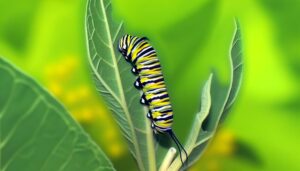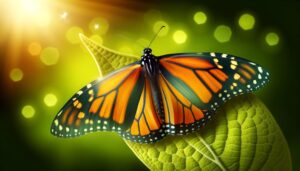Are Monarch Butterfly Caterpillars Poisonous? Discover!
Handling Monarch butterfly caterpillars with care is crucial. They absorb toxic cardiac glycosides from their exclusive diet of milkweed, which disrupt the sodium-potassium balance in predators, serving as a chemical defense mechanism.
It is important to handle them with care, preferably using gloves, and ensuring children or pets do not ingest them. Delving deeper will reveal intricate details about these captivating defense strategies and their ecological impact.

Key Takeaways
Monarch Caterpillar Appearance
Monarch caterpillars exhibit distinctive black, white, and yellow striping patterns that play an essential role in deterring predation by signaling toxicity to potential predators. These aposematic coloration patterns play a vital role in deterring predation by signaling toxicity.
The stripes aren’t random; they’re methodically spaced across the caterpillar’s body, enhancing their visibility. When you observe these caterpillars, you’ll notice that the coloration is most vivid during the larval stages, indicating their high toxicity levels.
The bright colors effectively communicate the presence of cardenolides potent steroid glycosides stored in their tissues.
Studies have shown that predators like birds quickly learn to associate these striking patterns with an unpleasant taste or toxic effects, thus avoiding the caterpillars. This visual strategy greatly enhances their survival rates.
Monarch Caterpillar Diet
You should understand that Monarch caterpillars exclusively consume milkweed, a plant that greatly influences their toxicity.
This diet provides essential nutrients and sequesters toxic compounds called cardenolides, which deter predators.
Consequently, the milkweed plant is vital for their survival and defense mechanisms.
Milkweed Plant Importance
Integral to the monarch caterpillar’s diet, the milkweed plant provides essential nutrients and chemical defenses necessary for its survival. You’ll find that milkweed contains cardiac glycosides, which the caterpillars sequester to deter predators.
This plant also offers carbohydrates and proteins critical for growth. Understanding these components can help you appreciate the monarch’s reliance on milkweed.
| Nutrient | Function | Importance to Caterpillar |
|---|---|---|
| Cardiac Glycosides | Chemical defense | Deterrent against predators |
| Carbohydrates | Energy source | Essential for metabolic activities |
| Proteins | Growth and development | Vital for muscle formation |
| Fiber | Digestive health | Aids in nutrient absorption |
Toxicity From Diet
Consuming milkweed plants rich in cardiac glycosides, monarch butterfly caterpillars accumulate these toxic compounds, making them unpalatable to predators.
Cardiac glycosides, also known as cardenolides, disrupt the cellular sodium-potassium balance in potential predators, causing them to experience toxic effects. Predators quickly associate the caterpillars’ bright coloration with this toxicity, leading to avoidance behavior.
Research confirms that the ingestion of milkweed directly correlates with the caterpillars’ toxicity levels. The higher the concentration of cardiac glycosides in the milkweed, the more toxic the caterpillar becomes.
This chemical defense mechanism offers monarch caterpillars significant protection against predation. You can observe that these adaptations are critical for their survival, underscoring the intricate relationship between their diet and their defense strategies.
Nutritional Needs
Monarch butterfly caterpillars primarily require milkweed for their nutritional needs, as it provides essential nutrients and the cardiac glycosides crucial for their chemical defense.
Milkweed is the sole food source for these larvae, ensuring the accumulation of toxic compounds that deter predators.
The ingestion of milkweed facilitates:
- Cardiac glycoside assimilation: Enhances toxic defense mechanisms.
- Protein intake: Supports rapid growth and development.
- Moisture content: Keeps caterpillars hydrated.
- Essential micronutrients: Promotes overall health and cellular function.
You’ll find that milkweed’s unique biochemical properties are indispensable for the caterpillars’ survival and metamorphosis. Without it, they can’t develop the necessary toxins that make them less palatable to predators.
Understanding these nutritional needs highlights the critical role of milkweed in the monarch’s lifecycle.
Milkweed and Toxicity
You need to understand that milkweed plants contain toxic alkaloids known as cardenolides.
When monarch caterpillars ingest these compounds, they sequester them within their tissues, creating a potent chemical defense mechanism against predators.
This process renders the caterpillars, and later the adult butterflies, unpalatable and often toxic to potential threats.
Milkweed Plant Alkaloids
Milkweed plants produce potent alkaloids known as cardenolides, which are toxic compounds that play an essential role in the monarch butterfly caterpillar’s defense mechanism.
These cardenolides, also referred to as cardiac glycosides, interfere with the sodium-potassium pump in animal cells, leading to potential toxicity in predators.
When you examine the relationship between milkweed and monarch caterpillars, you’ll find that these plants are important for the caterpillar’s survival.
Key points about milkweed’s cardenolides:
- Chemical Defense: Cardenolides act as a chemical deterrent against herbivores.
- Bioaccumulation: Monarch caterpillars sequester these toxins in their tissues.
- Variation: Different milkweed species contain varying levels of cardenolides.
- Impact: Predators consuming these toxins experience adverse physiological effects.
Understanding these aspects helps clarify how milkweed contributes to the caterpillar’s toxicity.
Caterpillar Defense Mechanism
Leveraging the cardenolides sequestered from milkweed plants, monarch butterfly caterpillars develop a potent chemical defense mechanism against predators.
When these caterpillars consume milkweed, the cardenolides, also known as cardiac glycosides, accumulate within their tissues.
Predators, such as birds and small mammals, ingesting these caterpillars experience toxic effects, including nausea and vomiting, deterring future predation attempts.
The cardenolides specifically inhibit the Na+/K+-ATPase enzyme, essential for cellular ion balance, leading to severe physiological disruptions in the predator’s body.
Additionally, the bright coloration of monarch caterpillars serves as an aposematic signal, warning potential predators of their toxicity. This combination of biochemical sequestration and visual warning enhances their survival, exemplifying a sophisticated evolutionary adaptation.
Chemical Defense Mechanisms
Monarch butterfly caterpillars employ a sophisticated chemical defense mechanism by sequestering toxic cardenolides from their milkweed diet to deter predators.
This process involves the uptake and storage of these toxic compounds, which are cardiac glycosides that interfere with cellular sodium-potassium pumps.
Understanding the caterpillars’ chemical defense mechanisms includes:
- Cardenolide Sequestration: They incorporate cardenolides into their tissues, making them distasteful.
- Dietary Specialization: Their exclusive milkweed diet is essential for effective toxicity.
- Metabolic Adaptation: They’ve evolved to tolerate high levels of cardenolides.
- Signal Transduction: Their bright coloration serves as an aposematic signal warning predators of their toxicity.
You’ll find that these mechanisms collectively enhance the caterpillars’ survival through biochemical deterrence.
Predators and Protection
Predatory threats to monarch butterfly caterpillars include birds, spiders, and wasps, which are often deterred by the caterpillars’ sequestered cardenolides. These toxic compounds, ingested from milkweed, render the caterpillars unpalatable and potentially harmful to predators.
Research indicates that cardenolides disrupt the sodium-potassium pump in animal cells, causing adverse physiological effects. Consequently, predators learn to associate the caterpillars’ distinctive coloration with toxicity, practicing avoidance.
Additionally, the caterpillars’ aposematic coloration serves as a visual warning signal, enhancing their survival.
However, some specialized predators, such as certain wasp species, have evolved mechanisms to tolerate or bypass these chemical defenses, posing a persistent threat.
Understanding these interactions underscores the complexity of ecological relationships and the evolutionary arms race between predators and prey.
Human Interaction Risks
When handling monarch caterpillars, you must use caution due to their potential to cause contact dermatitis in sensitive individuals.
Their toxicity also poses risks to pets, particularly dogs and cats, if ingested.
Evidence suggests that latex gloves can mitigate the chance of allergic reactions and protect both humans and animals.
Handling Caterpillars Safely
Handling monarch butterfly caterpillars requires caution due to the presence of cardenolides, which are toxic chemicals that can cause skin irritation or allergic reactions in humans.
To minimize risks, you should follow these safety protocols:
- Wear gloves: Use nitrile or latex gloves to prevent direct skin contact with the caterpillars.
- Wash hands thoroughly: Use soap and water immediately after handling to remove any potential toxins.
- Avoid touching your face: Reduce the risk of transferring cardenolides to sensitive areas like eyes or mouth.
- Supervise children: Make sure they understand the importance of these precautions to avoid accidental exposure.
Potential Allergic Reactions
Understanding the risks of potential allergic reactions is key when interacting with monarch butterfly caterpillars. Their cardenolides can trigger symptoms like skin rashes, itching, or even more severe responses in sensitive individuals.
Cardenolides, also known as cardiac glycosides, are toxic compounds sequestered by these larvae from their milkweed diet. When you touch these caterpillars, your skin may react to these substances.
Evidence indicates that allergic reactions can range from mild dermatitis to more intense symptoms such as hives or respiratory issues. Always wash your hands thoroughly after handling caterpillars to mitigate the risk.
If you experience any adverse effects, seek medical attention promptly. Understanding these potential risks helps you interact safely with these fascinating creatures.
Toxicity to Pets
Monarch butterfly caterpillars pose a significant toxicity risk to pets due to their ingestion of cardenolides, which can cause severe gastrointestinal distress and other symptoms in animals.
If your pet consumes these caterpillars, they might experience:
- Vomiting: An immediate and violent reaction to the cardenolides.
- Diarrhea: Persistent and often severe, leading to dehydration.
- Lethargy: Reduced activity and energy levels due to the toxins.
- Salivation: Excessive drooling as a response to irritation.
Veterinary intervention is critical if you suspect your pet has ingested a Monarch caterpillar.
Cardenolides, also known as cardiac glycosides, disrupt cellular function by inhibiting the sodium-potassium pump, potentially leading to cardiac and neurological complications.
Always monitor pets closely and keep them away from areas where Monarch caterpillars are present.
Comparing With Other Caterpillars
When comparing monarch butterfly caterpillars to other caterpillar species, it’s important to recognize the distinctive toxic compounds they possess due to their diet of milkweed.
Monarch caterpillars ingest cardenolides, a type of cardiac glycoside, which makes them unpalatable and toxic to many predators.
In contrast, other caterpillars, such as the tomato hornworm, may not exhibit such toxicity as they don’t consume plants containing these compounds.
Caterpillars like the woolly bear are known for their bristly hairs, which can cause irritation but aren’t toxic. The io moth caterpillar, however, has venomous spines that can deliver painful stings.
Each species’ toxicity is closely linked to their specific diet and evolutionary adaptations, underscoring the importance of understanding their ecological niches.
Research and Studies
Recent studies have meticulously documented how monarch butterfly caterpillars’ ingestion of milkweed-derived cardenolides confers both toxicity and a survival advantage against predation.
These cardenolides, or cardiac glycosides, integrate into the caterpillar’s tissues, making them unpalatable and toxic to many potential predators.
Specifically, researchers have observed:
- Enhanced predator deterrence: Predators like birds and small mammals avoid consuming these caterpillars due to their toxic properties.
- Quantitative analysis: High-performance liquid chromatography (HPLC) confirms the presence of cardenolides in caterpillar tissues.
- Genetic adaptation: Monarch caterpillars possess mutations in the Na+/K+-ATPase gene, offering resistance to cardenolide toxicity.
- Ecological implications: This toxicity influences predator-prey dynamics and contributes to the ecological stability of monarch populations.
Such findings underscore the critical role of milkweed-derived toxins in monarch caterpillar survival.
Safe Handling Practices
Proper handling of monarch butterfly caterpillars requires adherence to safety protocols to prevent exposure to their toxic cardenolides.
When you handle these caterpillars, wear disposable gloves to minimize direct skin contact. Cardenolides can cause skin irritation or allergic reactions in sensitive individuals.
Make sure you wash your hands thoroughly with soap and water after handling. Avoid touching your face, particularly your eyes and mouth, during and after contact.
Use sterilized tools, such as tweezers, to move the caterpillars, reducing direct interaction further. Maintain a clean environment by regularly sanitizing any surfaces or containers used for housing the caterpillars.
Following these practices mitigates potential risks and ensures your safety while studying or interacting with monarch butterfly caterpillars.
Benefits to Ecosystem
Monarch butterfly caterpillars play a crucial role in maintaining biodiversity by serving as a food source for various predators and contributing to the health of milkweed ecosystems through their feeding activities.
Their presence in ecosystems supports several ecological functions:
- Predator-prey dynamics: Monarch caterpillars provide an essential food source for birds, spiders, and other insects.
- Pollination: Adult monarch butterflies contribute to the pollination of various plant species, promoting genetic diversity.
- Ecosystem health: Caterpillar feeding stimulates milkweed growth, enhancing habitat quality.
- Nutrient cycling: Decomposing caterpillar bodies enrich the soil with essential nutrients.
Understanding these benefits underscores their importance in maintaining ecological balance and emphasizes the need to protect their populations.
Conclusion
You’ve now got a thorough understanding of monarch butterfly caterpillars, including their striking appearance, specialized diet, and the fascinating chemistry behind their toxicity.
These larvae, with their unique defense mechanisms, are adept at deterring predators. When compared to other caterpillars, their chemical armory stands out. Studies confirm their ecological significance.
Exercise caution when handling them to avoid any unpleasant experiences. Monarch caterpillars, despite their delicate appearance, play an important role in maintaining ecological balance.






